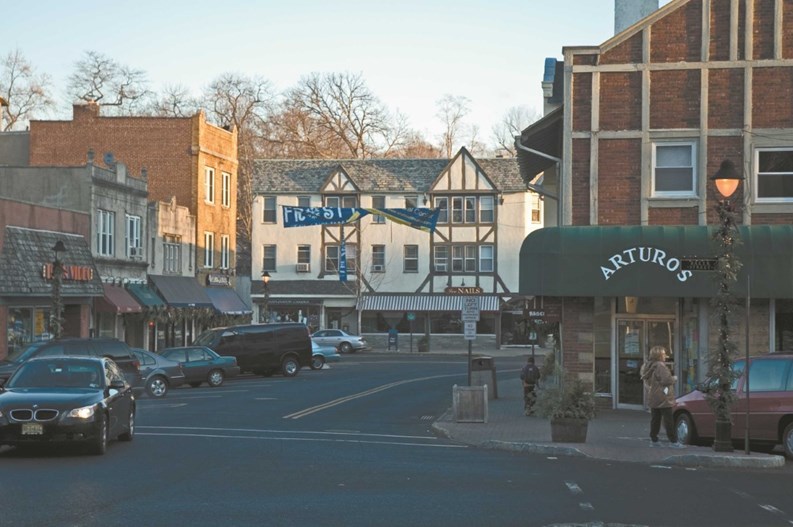When surveying the area now known as Maplewood, Robert Treat found several trails used by the Lenape tribes of Algonquin Native Americans, though there was only sparse settlement. Many of these paths form the basis for the town's main thoroughfares today.
The first European settlers arrived in 1675 via Newark and Elizabeth, previously they had lived in Hempstead, Long Island, and Stamford, Connecticut. The settlers had acquired most of today’s Essex County from the Native Americans and followed three trails that roughly correspond to South Orange Avenue, Springfield Avenue, and Ridgewood Road. These three routes resulted in three separate communities that merged into Maplewood and South Orange.
Six families came up today’s Ridgewood Road and established scattered farms around a center that became Jefferson Village, named after Thomas Jefferson. This village, which roughly corresponds to downtown Maplewood today, developed several mills and orchards. John Durand, the son of Hudson River school painter Asher Brown Durand, describes the place as a picturesque but slightly backwards community. The apple harvest was apparently quite impressive and included “Harrison” and “Canfield” varieties. By 1815, there were approximately 30 families in the village.
Those who traveled up today’s Springfield Avenue settled on a hill crest near today’s intersection between Tuscan and Springfield Avenue and established a hamlet known as North Farms. Over time, this community became known as the Hilton section. It became a stagecoach stop between Newark, Jersey City (then Paulus Hook), and Morristown and thereby a center for trade and light manufacturing. The village changed its name from North Farms to Middleville in 1830, and then to Hilton in 1880 when it was granted a post office. In 1855, Seth Boyden settled in what was then Middleville to retire but innovated a number of agricultural products, especially berries. Boyden also built and put into operation the first steam engines to service the railroad through Maplewood. The area became known for its orchards and related industries, including cider mills and distilleries of rum, but also honey and some livestock.
Maplewood was originally formed as South Orange Township, which was created on April 1, 1861, from portions of Clinton Township and what was then the Town of Orange. The name of the township was changed to Maplewood on November 7, 1922.
When the Morris and Essex Railroad from Newark was extended to the area in 1838, a land speculator by the name of John Shedden built a railroad station in Jefferson Village and named it Maplewood. This name came to comprise areas known as Hilton, Jefferson Village, and areas previously that were part of Springfield. In 1868, farms were divided into parcels for residential housing. During the 1920's there was significant growth which foreshadowed the suburb we know today.
Many of the more recognizable buildings and spaces were the work of famous architects and landscape designers. Most of the schools and the Municipal Building were the work of Guilbert & Betelle. The center of town is dominated by Memorial Park, a design of the Olmsted Brothers, whose father designed New York City's Central Park. The Maplewood Theater, where Cheryl Crawford first revived Porgy and Bess, was designed by William E. Lehman.
Maplewood covers 3.8 square miles. There is a pond located in Memorial Park, the Rahway River runs through the town, and there is a municipal pool club with four man-made pools.
Maplewood prides itself on being a diverse and family-friendly community. In a number of surveys it is ranked among the most desirable places to live in the United States. The township has a downtown area alternatively known as "The Village" or "Maplewood Center" with a movie theater, several upscale and mid-scale restaurants, specialty shops and a supermarket. Just east of “Maplewood Center,” and south of Memorial Park is the Maplewood Golf Course which boasts award-winning links and tennis courts.
All of this is easy to get to since Maplewood is served by a New Jersey Transit rail station, making it an ideal commuter town, and the rail station has remained relatively the same since the 1950's. Getting off the train it's just a short walk to such favorite local dining destinations like Lorena's, Arturo's Wood Fired Pizzeria & Osteria and Sona Indian restaurant.
With Memorial Park and the Maplewood Golf Course set right in the middle of the township, Maplewood is a wonderful town to take a stroll and maybe meet up with friends for a pint and a game of pool at O'Reilly's Irish Pub, which is located just south of the golf course.
Maplewood has become a center for the arts in northern New Jersey. The township owns and operates the Burgdorff Center for the Performing Arts on Durand Road. Every year, during the weekend following the weekend closest to July 4, there is a concert in town called Maplewoodstock. The free concert consists of local and national bands performing alongside various stalls showcasing local businesses.
Centrally located to “The Big Apple,” Maplewood is a vibrant community that provides all the amenities of the city. But it still retains that small township feel (its population is less than 25,000). It's no wonder that people have been drawn to this undiscovered gem in northern New Jersey for more than 300 years.
Liam P. Cusack is associate editor of The New Jersey Cooperator.




Leave a Comment